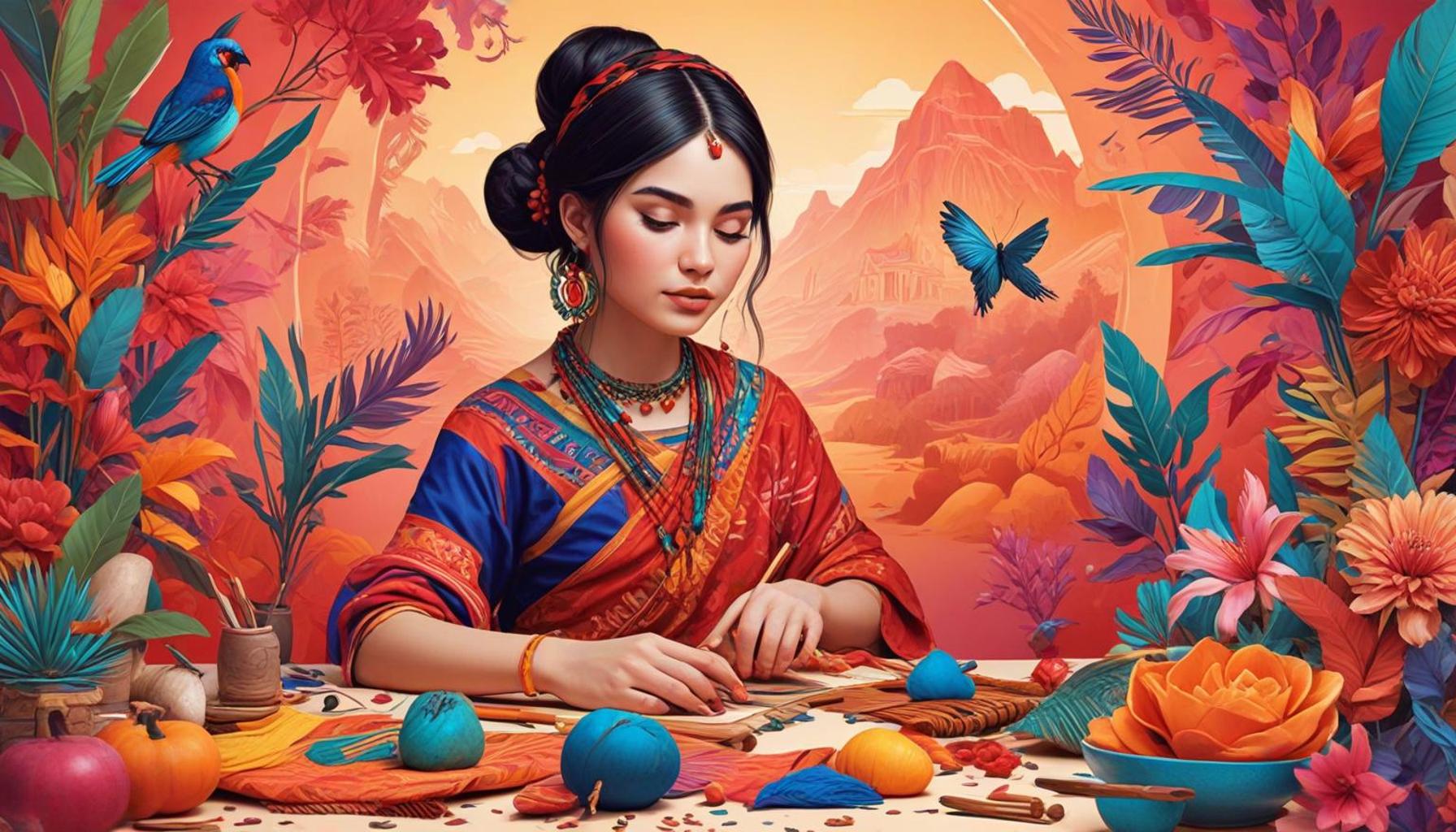Reimagining Traditions: Craft Projects that Rescue Cultures and Histories

The Role of Crafting in Cultural Preservation
In an ever-changing world, the act of crafting has become a powerful medium to rescue and reinterpret cultural traditions. These practices encompass a variety of forms, from Indigenous artistry to the vibrant styles of immigrant communities, illustrating that craft projects are not merely artistic expressions—but essential connections to our shared histories.
Consider the impact of such projects:
- Preserving heritage: Craftspeople breathe new life into ancient techniques, ensuring that future generations remember their roots. For instance, the revival of Gullah basket weaving in the southeastern United States reflects a rich cultural heritage, as artisans combine traditional methods with contemporary designs, teaching younger generations the significance of their craft.
- Fostering community: Local workshops often bring diverse groups together to learn, share, and celebrate their unique cultural identities. Programs like “Crafting Community” in Chicago create spaces where individuals from various backgrounds come together, exchanging stories and skills, ultimately enriching the fabric of community cohesion. By participating in these workshops, individuals not only learn about different cultures but also contribute their own traditions.
- Encouraging sustainability: Utilizing traditional methods and natural materials often promotes environmentally friendly practices. Crafting with recycled materials or sustainably sourced components is a growing trend. For example, Native American artisans frequently use natural dyes derived from plants, demonstrating that their craft not only celebrates cultural identity but also champions ecological responsibility.
Whether it’s weaving, pottery, or quilting, each crafted piece tells a story laden with history. These narratives are crucial for the revitalization of cultural legacies, offering individuals a sense of belonging and pride in their ancestry. The quilting bees, often a significant event in many African American communities, serve not only as a way to create beautiful quilts but also as opportunities to pass down family histories and connect generations.
As you delve into the world of transformative crafts, you’ll discover how creativity and culture can coalesce. From artisan fairs that showcase local crafts to online platforms connecting global artisans, the engagement with traditional crafts is on the rise. Join us on this journey as we explore the projects that are redefining our understanding of tradition in contemporary society, revealing the intricate tapestry of culture that binds us together through time and space.
DISCOVER MORE: Click here to enhance your creativity

Reviving Ancient Techniques through Modern Innovation
Throughout history, craft has served as a reflection of identity and community, evolving alongside societal changes. In the quest to preserve cultural heritage, many contemporary artisans are reimagining traditional techniques by merging them with modern aesthetics. This fusion not only revitalizes ancient crafts but also speaks to a younger generation, igniting a renewed interest in their cultural roots.
Taking the art of ceramics as a prime example, many potters in the United States are now incorporating Indigenous designs that have been passed down through generations. By utilizing traditional glazing methods alongside contemporary forms, these artisans allow their work to convey stories of ancestry while appealing to a modern audience. Programs like the Clay Studio’s “Emerging Artists” initiative encourage young potters to blend cultural motifs with their own artistic flair, creating innovative pieces that resonate with both history and present-day sensibilities.
Another compelling instance is observed in the textile arts, where traditional quilting patterns are being embraced with new narratives. Quilts are historically significant in African American communities, serving as a form of storytelling during times of hardship. Modern makers have adopted this legacy, often incorporating contemporary themes that address current social issues. Their works not only pay homage to the quilts of the past but also invoke discussions about equality, resilience, and the ongoing battle against discrimination.
- Innovative Basket Weaving: The resurgence of basket weaving in various communities highlights the creative repurposing of materials such as recycled plastic and natural fibers. Artisans are transforming age-old techniques into sustainable practices, ensuring that their cultural stories continue to flourish in an environmentally-conscious context.
- Contemporary Embroidery: Many craftspeople are adding a modern twist to embroidery, integrating political messages or social commentary within traditional patterns. This dynamic approach breathes new life into a centuries-old craft, making it relevant to today’s conversations about identity and cultural expression.
- Woodworking Revitalization: In woodworking, artisans are rediscovering traditional carving techniques to create contemporary furniture pieces rich with storytelling. A blend of aesthetic beauty and cultural significance characterizes their works, inviting broader audiences to appreciate craftsmanship.
The innovation seen in these craft projects acts as a bridge, connecting the legacies of the past with the pulse of modern life. Each piece created is more than a singular object; it is a testament to the resilience and adaptability of culture. As artisans share their knowledge through workshops and social media, they not only preserve cultural techniques but also cultivate a sense of urgency to explore and understand the cultural narratives embedded within these crafts.
In this journey of exploration, we unveil the true potential of craft not only as a means for personal expression but also as a vehicle for cultural education and revitalization. As the dialogue around these projects grows, so too does the understanding that the arts can serve as a lifeline for history, tradition, and community.
Reimagining Traditions: Craft Projects that Rescue Cultures and Histories
Craft projects that focus on cultures and histories not only preserve the past but also serve as a vibrant medium for contemporary artists to express their creativity. These initiatives often involve local artisans who blend traditional techniques with modern aesthetics, ensuring that ancient practices are not lost to time. By engaging with local narratives, projects become conduits for cultural exchange, fostering a sense of community and belonging.
| Advantage | Impact |
|---|---|
| Preservation of Heritage | These projects help maintain traditional crafting techniques, ensuring cultural practices are taught to future generations. |
| Economic Empowerment | Artisans gain financial support through sales, allowing communities to thrive economically while expressing their identities. |
These projects are a powerful reminder of the interconnectedness of art, culture, and history. As artisans reimagine traditions, they not only reinvent their own roles within their communities but also offer the global audience a glimpse into the richness of diverse cultural expressions. Exploring these craft initiatives opens doors to understanding the broader implications of cultural heritage in our modern world.
DISCOVER MORE: Click here to uncover unique crafting techniques
Revitalizing Cultural Narratives through Collaborative Projects
As the conversation around cultural preservation and craft continues to grow, collaborative projects have emerged as a critical element in reimagining traditions. These initiatives not only unite artists and cultural custodians from diverse backgrounds but also serve as a platform for storytelling, teaching, and celebration of heritage. By engaging multiple generations within a community, these projects create a dynamic interchange that honors the past while forging new paths for the future.
One notable example is the Craft in America program, which brings together artisans from various cultural backgrounds to showcase the importance of handmade crafts in different communities. Through exhibitions, residential workshops, and educational programs across the country, participants learn about specific craft traditions while sharing their unique narratives. This collaborative approach fosters understanding and appreciation of cultural diversity, encouraging artisans to incorporate elements from each other’s backgrounds into their practice.
Furthermore, the Folk Art movement has played a significant role in this revitalization. By focusing on local crafts—such as pottery, weaving, and folk painting—this movement not only preserves age-old techniques but also introduces them to emerging audiences. Projects like the Smithsonian Folklife Festival allow artisans to interact directly with visitors, sharing insights into their craft while exploring the broader social implications of their work. This creates an environment where traditional techniques are viewed not merely as relics but as living practices actively shaping contemporary culture.
- Intergenerational Craft Workshops: Many communities are hosting multigenerational workshops that bring grandparents and grandchildren together to learn traditional crafts. By passing down skills such as beadwork, weaving, and woodworking, these programs not only preserve techniques but also strengthen familial bonds and shared narratives.
- Online Platforms for Global Collaboration: The rise of social media has allowed artisans to connect and collaborate on a global scale. Platforms like Instagram and TikTok have transformed the craft community, enabling artists to share their traditions, techniques, and stories with a worldwide audience, thus fostering cultural exchange and innovation.
- Artist Residency Programs: Several institutions across the United States now offer residencies specifically aimed at artists focused on cultural traditions. These programs encourage artists to delve into their cultural backgrounds, experiment with new materials or methods, and produce works that challenge preconceived notions about their heritage.
The power of collaboration is evident in projects such as the Weaving the Future initiative, which partners skilled weavers from Central America with American textile artists. By sharing techniques and exploring themes surrounding migration and identity, participants create hybrid works that narrate personal and collective histories. This blending not only revitalizes traditional weaving practices but also opens up dialogue about the cultural dynamics of displacement.
In recognizing the importance of such collaborative efforts, it becomes clear that rich cultural history lies not just in isolation, but rather in the collective engagement that sustains and transforms it. By fostering connections through these craft projects, we not only honor the past but also pave the way for a more inclusive, diverse, and vibrant future for all. This intersection of tradition and modernity invites us to re-examine our relationships not just with the craft itself but with one another, creating a tapestry rich with shared stories and experiences.
DISCOVER MORE: Click here to learn how gardening can boost your creativity and well-being
Conclusion
As we navigate an increasingly globalized world, the importance of reimagining traditions through craft projects cannot be understated. These initiatives serve as powerful tools for cultural preservation, allowing communities to assert their identities while simultaneously embracing innovations that reflect their evolving narratives. By fostering collaborative environments where artisans and storytellers from diverse backgrounds converge, traditional techniques are not merely safeguarded; they are reinvigorated with new life and meaning.
Through programs like Craft in America and festivals such as the Smithsonian Folklife Festival, the conversation surrounding craftsmanship transcends generational divides. This dialogue not only unearths the rich histories embedded within different art forms but also encourages intergenerational connections that strengthen communal ties. As these craft projects spur on cultural exchanges, they equip participants with the tools to navigate their heritage’s complexities while respecting and celebrating the diverse resources available.
The challenges posed by the modern world do not diminish the relevance of traditional crafts; instead, they provide an opportunity for dynamism and innovation. By engaging with craft in a contemporary context—be it through online platforms, workshops, or artist residencies—communities are reshaping how cultures express themselves. This vital work invites us all to participate in the ongoing stories of our heritage, recognizing that every thread woven into the fabric of culture enriches our collective experience.
Ultimately, the craft projects that emerge from this reimagining are more than aesthetic endeavors; they are living histories that remind us of our shared humanity. By participating in or supporting these initiatives, we contribute to a vibrant tapestry that honors the past while paving the way for future generations to find resonance within their cultural landscapes.
Related posts:
Virtual Craftsmanship: Creating Online Communities and Sharing Projects
DIY for Beginners: Simple Craft Projects to Get Started
Digital Craft: How to Use Technologies to Create Innovative Projects
Crafts and Mental Health: How Creating Can Help Reduce Stress
Personalization Techniques in Craft Projects: Transforming Common Items into Unique Pieces
Craftsmanship and Well-Being: Projects that Promote Personal Connections and Self-Expression

Linda Carter is a writer and creative hobbies expert specializing in crafting, DIY projects, and artistic exploration. With extensive experience helping individuals discover their creative potential and bring their ideas to life, Linda shares her knowledge on our platform. Her goal is to empower readers with practical tips, inspiring ideas, and step-by-step strategies for success in the world of creative hobbies.